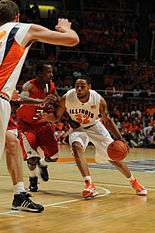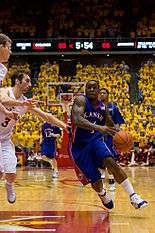Key (basketball)
The key, officially referred to as the free throw lane by the National Basketball Association (NBA) and the National Collegiate Athletic Association (NCAA), the restricted area by the international governing body FIBA, and colloquially as the lane or the paint, is a marked area on a basketball court surrounding the basket. It is bounded by the endline, the free-throw line and two side lines (freebody lines), and usually painted in a distinctive color. It is a crucial area on the court where much of the game's action takes place.
Dimensions of the key area have varied through the history of the game. Since the 2010 FIBA rule amendments (implemented following the 2010 FIBA World Championship), its shape is rectangular for games sanctioned by all three associations, 16 feet (4.9 m) wide for both NBA and FIBA keys, and 12 feet (3.7 m) for NCAA keys. Prior to 2006, the key in FIBA-sanctioned tournaments was a trapezoidal shape.
The most-commonly enforced rule on the key is the "three seconds rule" in which the team of a player on offense who stays on the key for more than three seconds loses possession of the ball. Another rule is the lane violation which occurs if a player from either team enters the key before a free-throw shooter releases the ball in the act of shooting. A recent innovation is the introduction of the restricted area arc directly underneath the basket where the defending player cannot force an offensive foul on the opposing player.
Dimensions
Each level of play has different specifications for the size and shape of the key: in American leagues, where the basketball court is measured in US units, the shape is rectangular, while in FIBA-sanctioned events, which use the metric system, the shape was trapezoidal before being changed to a rectangle as well. In addition to the bounding rectangle, the key includes a free-throw circle at its head or top.
The width of the key in the NBA is 16 feet (4.9 m), including the 2-foot (0.6 m) wide foul lanes;[1] in U.S. college (NCAA) and high-school play, it is 12 feet (3.7 m).[2]
Beginning after the 2010 FIBA World Championship, all FIBA-administered tournaments use a rectangular key 4.9 meters (16 ft) wide.[3] From 1956 until 2010, FIBA-sanctioned tournaments used a trapezoidal key. The narrower end was on the free-throw line, where it was 3.6 meters (12 ft), while the wider end, at the end line, measured 6 meters (20 ft).[4]
The free throw circle has a six-foot (1.8 m) radius centered at the midpoint of the free throw line. The half-circle on the mid-court side of the free throw line is painted solid. In the NBA and ULEB, the boundary of the half closer to the basket is traced in a broken line in order to space players properly for jump balls. NBA Rule 1 (g) requires the key to contain two 6 inches (15 cm) long hash marks, 3 feet (0.91 m) from the free throw line; the marks indicate the so-called lower defensive box. The free throw line is 15 feet (4.6 m) from the perpendicular projection of the face of the backboard onto the court; this projection is 4 feet (1.2 m) from the end-line for NBA and NCAA. The projection of the center of the basket onto the court is a perpendicular distance of 1.575 meters (5.17 ft) from the end line in FIBA tournaments,[3] but 4.75 feet (1.45 m) in NBA and NCAA tournaments.[1][2]
| NBA | NCAA (U.S.) | FIBA (until 2010) | FIBA (since 2010) |
|---|---|---|---|
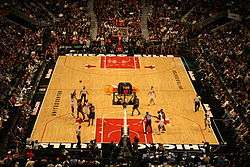 |
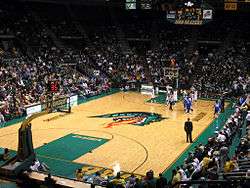 |
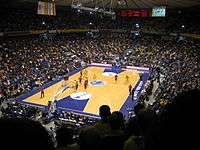 |
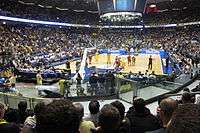 |
| NBA basketball courts have a rectangular key with a restricted area arc nearest to the basket. In the NBA hash marks are displayed in the half-circle nearest the basket to facilitate jump balls in the free throw lane. The NBA and NCAA keys may be marked with both of their key lines to allow use of the same floor by the other group. This is also common for college arenas that are used for NBA exhibition games or the NBA G League. | On NCAA basketball courts the free throw half-circle nearest the basket has no hash marks because there is no jump ball held in the free throw lane. | Prior to 2010, in FIBA-affiliated leagues, courts such as the Nokia Arena had trapezoidal keys. Until 2003, the half circle was displayed, but many sponsors use that section of the arc for advertising. | After the changes ordered by FIBA took effect in 2010, all FIBA-spec arenas (like the Nokia Arena) changed to rectangular keys (just like in the NBA), but the lines used to denote the 12-foot boundary in NBA keys are not present. Sponsors may use the inside arc for advertising in FIBA play. For Euroleague play, the half-circle is required since jump balls are conducted in the free throw lane (as of 2013). |
History

Originally, the key was narrower and was shaped like a keyhole, measuring six feet (1.8 m) wide, hence its name "the key", with the free-throw circle as the head, and the shaded lane as the body. It has been also called "cup" or "bottle" in other languages, because of how it looks from other perspectives. Due to the narrow key, imposing centers, such as George Mikan, dominated the paint, scoring at will. To counter this, the key was widened into 12 feet (3.7 m) from 6 feet (1.8 m) at the onset of the 1951–52 NBA season.[5]
Men's professional basketball in the United States (the National Basketball Association) widened it further to 16 feet (4.9 m) in the 1964–65 NBA season to reduce the effectiveness of dominant centers, especially Wilt Chamberlain.[6] The NCAA retains the 12‑foot key to this day.
On April 25, 2008, the FIBA Central Board approved rule changes that included the shape of the key. It is now rectangular and has virtually the same dimensions as the key used in the NBA. In addition, the no-charge semicircle formally called the restricted area arc was also created.[7] The change took effect in 2010.
Rules
Three-second violation
The lane is a restricted area in which players on offense (in possession of the ball) can stay for only three seconds. At all levels of play, after three seconds the player is assessed a three-second violation which results in a turnover.[6]
In FIBA-sanctioned tournaments, defending team players are allowed to stay in the key with no time limit. In American professional basketball, defending team players are prohibited from staying in the key for more than three seconds, unless the player is directly guarding an offensive player. Otherwise if a defender exceeds that time, the defending team is charged with a defensive three-second violation, which results in a technical foul where the team with the ball is awarded one free throw, plus retaining possession and a reset of the shot clock.[4] In all cases, the clock resets if the shot hits the rim or if the player steps out of the lane.[8]
Lane violation


When a player is shooting free throws, a certain number of players are allowed at the boundaries of the key, each occupying a slot traced at the boundaries of the key. The free throw shooter is behind the free throw line, and in most leagues three of his opponents are along the sides of the key, one side with two players, the other with one. Two of his opponents are situated nearest to the basket on both sides, while his two teammates are beside the two opponents closest to the basket, with the other player from the opposing team situated farthest from the basket.[1][3] In the U.S. NCAA, there are as many as six players along the key, with the opposing team allowed to have as many as four players, with the same arrangement as in the NBA and FIBA but with another player facing his teammate farthest to the basket.[2]
No player along the lane may enter the key until the shot is released. The player shooting the free throw, and anyone at top of the key, may not cross the free throw line until the ball hits the rim. If any of the offensive players violate the rule, no points are awarded for the shot and, if there are no more shots remaining, the ball is given to the defending team. If a defending player enters the lane too soon, an extra shot will be awarded regardless of whether the shot was made or missed.[1][2][3]
In FIBA play, if the shooter commits the violation, it is an automatic turnover. If the shot is successful and the shooter does not commit a violation, but other players do commit a violation, all violations are dismissed. If players on the opposing team enter the key prior to the release of the ball, a jump ball determines who gets the possession of the ball (NBA) or the possession arrow rule (for all other levels). In FIBA play, that only applies if the shooter misses, since a successful attempt negates all other penalties.[1][2][3] In all situations, lane violation penalties cannot occur if there are further free throws pending.[9]
Restricted area arc
In the NBA, Euroleague, and in FIBA and NCAA play, the key has an arc extending four feet from the basket (NBA and NCAA), or 1.25 meters (approximately 4.1 feet) (FIBA). The area behind the arc, or the arc itself is called the "restricted area" (RA) in the NBA, the "restricted area arc" in the NCAA and the "no-charge semicircles" in FIBA.[10]
Its purpose is to prevent secondary defenders from taking a position under the basket in an attempt to draw an offensive foul while a player is driving to the basket. If a player on offense drives past his primary defender on the way to the basket and a secondary defender steps in, he must establish a position outside the RA to draw an offensive foul. If the drive starts inside the Lower Defensive Box (LDB – the area from the bottom tip of the free throw circle to the end line between the two 3‑foot posted-up marks), the secondary defender is allowed to be positioned inside the RA. The restricted area does not apply if the secondary defender jumps in attempting to block the shot, and the offensive player leads with his leg or knee in an unnatural motion or uses his off arm to prevent the defender from blocking his shot. The RA does not extend from below the backboard to the baseline. Therefore, if a player drives the baseline and is not attempting to go directly to the rim, the RA does not apply.
The restricted area arc rule first appeared at any level of competition in the NBA for the 1997-98 season.[11] It was applied in NCAA men's basketball for the 2010–2011 season. The NCAA approved adding a visible restricted-area arc three feet from the center of the basket in Division I men’s and women’s games for the 2011–2012 season. The panel delayed implementation of the arc until the 2012-2013 season for Divisions II and III to allow those schools more time to plan and place the restricted-area arc in their home arenas.[12] Starting with the 2015-2016 season, the NCAA moved the RA arc out to four feet from the center of the basket.
Terms
Points made on the key are termed as points in the paint or inside points. Historically, the area of the key where offensive players are prohibited from remaining longer than three seconds has been painted to distinguish the area from the rest of the court; hence the phrase "points in the paint." The area around the free throw circle's farthest point from the basket is called the "top of the key", and several plays revolve around this area, such as screens and pick and rolls. In American women's collegiate basketball (and for men until 2008), the three-point arc intersects at the top of the key, which could translate plays conducted in this area into three-point field goal conversions.
The intersection of the free throw line and the free throw lane is referred to as the elbow of the key.[13]
References
- 1 2 3 4 5 "Official Rules of the National Basketball Association 2007–08" (PDF). NBA.com. Retrieved 2009-10-04.
- 1 2 3 4 5 "NCAA Basketball: 2008 Men's and Women's Rules and Interpretations" (PDF). http://www.rolltide.com/. Archived from the original (PDF) on 2011-08-07. Retrieved 2009-10-04. External link in
|publisher=(help) - 1 2 3 4 5 "Official Basketball Rules 2010" (PDF). FIBA.com. Retrieved 2010-11-18.
- 1 2 "Official Basketball Rules 2006" (PDF). FIBAAmericas.com. Retrieved 2010-11-18.
- ↑ Jeramie McPeek. "George Mikan vs. The Knicks". NBA.com. Retrieved 2007-10-12.
- 1 2 "NBA Rules History". NBA.com. 2008-05-02. Retrieved 2009-10-02.
- ↑ "The FIBA Central Board approves historic rule changes". FIBA.com. 2008-04-26. Retrieved 2009-10-04.
- ↑ "GLOBAL Basketball DIRECTORY (Tha-Tid)". eba-stats.com. 2007-02-11. Retrieved 2007-10-12.
- ↑ "GLOBAL Basketball DIRECTORY". eba-stats.com. 2007-09-07. Retrieved 2007-10-12.
- ↑ "NBA's Misunderstood Rules". NBA.com. 2012-01-03. Retrieved 2018-04-23.
- ↑ "Shaq and the No Charge Zone Rule". Factuation. Factuation. July 1, 2015. Retrieved February 27, 2018.
In the 1997-1998 season, NBA added the “no charge zone” or the “restricted area”. This is the portion of the key, denoted by an arc in the painted area that is positioned four feet from the basket. The arc is important because a defending player can not force a charging foul within this area. It was designed to provide benefit offensive post-up player like [Shaquille] O’Neal, players who drive to the basket and limit collisions.
- ↑ "Rules panel approves restricted-area arc for Div. I". Ncaa.org. Retrieved 3 March 2012.
- ↑ Newll, Pete; Nater, Swen (2008). Pete Newell's Playing Big. Human Kinetics. p. 26. ISBN 9780736068093. Retrieved April 10, 2013.

